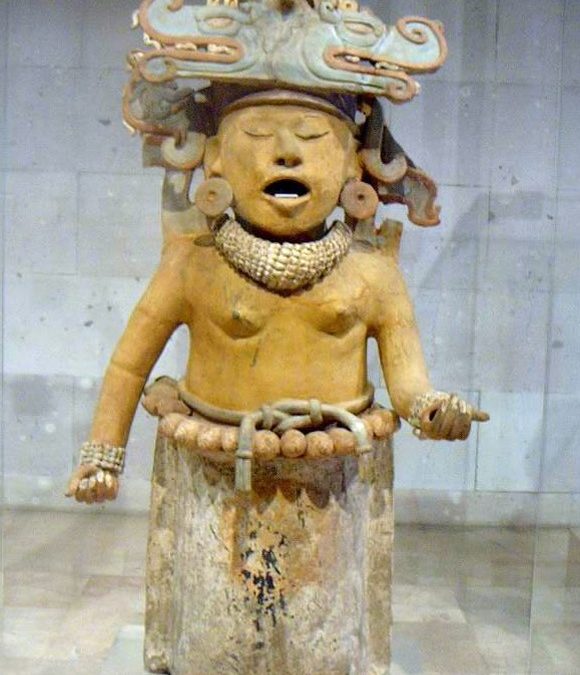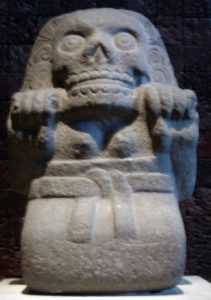The cosmology of the Mesoamericans presents a lush, complex landscape of deities and ideas. Study of this cosmology, through a particularly feminist lens, reveals powerful female deities. Among the most intriguing are the Cihuateteo[1].
The Cihuateteo (literally “women goddesses”)[2] appear in the pantheon of Mesoamerican cosmology as mortal women who died in childbirth and were then deified[3]. In regular cycles, the Cihuateteo traversed the heavens, the underworld, and the earthly plane. Daily they dwelt with the stars in the western sky in the heavenly region called Cihuatlampa (“place of women”) and accompanied the sun from noon to sunset, then through the night as it lit the underworld[4]. Every 52 days[5] in the ritual calendar[6], the Cihuateteo descended to earth to reign for a day associated with the west. It is the very regularity of the Cihuateteo’s presence that places them habitually in the lives of the Mesoamericans.
In central Mexico, Goddesses were worshipped at cihuateocalli (“goddess houses”) of different sizes and locations. The Cihuateteo were honored in neighborhood cihuateocalli built at the crossroads. During the days of the Goddesses’ descent, their images in the shrines were festooned with paper (amatetéuitl) pegged to the statues with bits of rubber or copal[7]. They were given offerings of tamales[8] and toasted corn, as well as bread shaped as butterflies and lightning rays.
On the days the Cihuateteo descended, children were cautioned to stay inside and men were warned to be careful, as contact with these Goddesses could cause palsy. These admonitions have historically been used to paint the Cihuateteo as maleficent beings. I offer another interpretation, seeing the days they descended as times when possession was imminent and viewing palsy as a symptom of possession. Only those who were skilled in dealing with divine possession should be outside on the days the Cihuateteo descended.
The negative framing of these Goddesses has led to their continued demonization. Modern writings compare them to vampires and other maleficent specters. However, according to the veneration practices of the Mesoamericans, the Cihuateteo are powerful, benevolent and munificent ancestors.
One of the most beautiful tributes to the Cihuateteo was the prayer that the midwife recited at the death of a young mother.[9] In this prayer the midwife cried at the death of her patient, urging the parents to be glad that their child had died in childbirth because she would become a Goddess and accompany the sun as a brave one, a mocihuaquetzque[10]:
My little one, my daughter, my noble woman, you have wearied yourself, you have fought bravely. By your labors you have achieved a noble death, you have come to the place of the Divine. …Go, beloved child, little by little towards them (the Cihuateteo) and become one of them; go daughter and they will receive you and you will be one of them forever, rejoicing with your happy voices in praise of our Mother and Father, the Sun, and you will always accompany them wherever they go in their rejoicing. (Sahagún 381-382)
At the end of the prayer, the midwife exhorted the new Cihuateotl not to forget her and all those left on earth, to remember and aid them as they led their hard lives on the earthly plane. This prayer portrayed the Cihuateteo as benevolent beings, honored and revered.
Throughout this prayer, the Cihuateteo were referred to in militaristic terms. They were called “brave” and extolled for “fighting bravely”, and their daily journey with the sun from noon to dusk mirrored the slain warrior’s journey with the sun from dawn to noon. The Cihuateteo were literally the embodiment of bravery. In fact, warriors would attempt to sever the middle finger of the dead woman’s left hand to use as a talisman to assure their own bravery and success in battle. The midwives and family members who carried her to her grave had to stop warriors from dismembering the body of the Cihuateteo.
The question of why the Cihuateteo were described in militaristic terms and venerated in the same way as warriors who died in battle has been much debated. Melgarejo Vivanco wrote that the Cihuateteo were given the same honor as dead warriors because it helped promote motherhood “with the incentive of deification” (167). A militaristic society, he noted, must be supplied with soldiers. This is a commonly repeated theory.
|
Cihuateotl. Provenance: Mexico City. Note the skeletolized face and clawed fingers (clawed toes not visible). Belt around waist has similar ollin style knot.
Photo © Anne Key. |
However, honoring women by comparing them to warriors assumes that warriors had died in battle before women died in childbirth[11]. I suggest that the scenario of the Cihuateteo existed before the culture knew war[12], and that the increasingly militaristic Mesoamerican society may have co-opted a longstanding custom of honoring women who died in childbirth to valorize its practices.
It can then be posited that warriors were given the same status as women who died in childbirth; that as an incentive for warriors to go into battle, they were to be honored as women had been honored for centuries, perhaps millennia. Women dying in childbirth were the exemplars of courage, given the highest honor available to mortals — to journey with the sun. Warriors would share this honor, giving them the same status as the Cihuateteo.
The iconography associated with the Cihuateteo differs in the various regions. The Cihuateteo statues from the state of Veracruz were modeled after the deceased bodies of individual women who died in childbirth. Multivalent symbols appear on these statues: fantastic headdresses represent the sky dragon and the earth monster; bicephalic pit-vipers wrapped around their waists represent internal female organs and attributes of deities associated with death. The vipers are tied in a knot similar to the glyph ollin, which means “movement”.
The most striking aspect of these statues is their humanness. These were real women — the artisans’ contemporaries, possibly their relatives, friends, part of their community. They were rendered as fleshy, corporeal, mortal, real. Every post-mortem detail was captured. I believe it is this humanness that makes these statues a true testament to the deceased women — they were truly revered ancestors.
In contrast, the Central Mexican Cihuateteo do not have individual characteristics; there is little variance among them. These statues are kneeling and have descarnated faces and clawed feet, contrasted with their long, luxurious hair. On the top of some of their heads, a day glyph of one of the days of the Cihuateteo’s descent is designed into the hair. Their belts or snakes are tied in the similar ollin glyph style knot. Their breasts are bared, visible above their knotted belts and skirts.
The Cihuateteo were the beloved and brave women who died in the act of childbirth. The midwife’s prayer assured the mother that her death had not been in vain, that she would be remembered for her act of bravery. The prayer poignantly expressed the bravery of the Cihuateteo, showing their honored place with the sun. There was no doubt that the Cihuateteo were powerful deities. Traversing the celestial, earthly, and underworld spheres and honored in neighborhood shrines, they were an integral part of the spiritual landscape of the Mesoamericans.
Notes
- All translations from the Spanish or Nahuatl are mine.
- Cihuateteo (pl); Cihuateotl (sing).
- See Pomeroy for speculation that Spartan women who died in childbirth were also honored in the same way as warriors slain in battle.
- The underworld portion of this cycle is not explicitly stated in Sahagún’s writings but can be found elsewhere. See Key for evidence and sources.
- The 260-day ritual year was divided into 20 time periods called trecenas (from the Spanish trece meaning 13) made up of 13 days each. There were four sets of trecenas, each associated with one of the four directions. So in the whole 260-day cycle, five individual trecenas were associated with a single direction. The Cihuateteo descended on the first day of each trecena associated with the west: the 3rd, ce mazatl (one deer); the 7th, ce quiahuitl (one rain); the 11th, ce ozomatl (one monkey); the 15th, ce calli (one house); and the 19th, ce quauhtli (one eagle).
- It has been suggested that this 260-day ritual cycle follows the human gestation period from the first sign of life to birth (covering 9 lunations) and is intricately associated with female cycles. See Tate for further information.
- Copal is a fragrant tree resin burned in ritual. It is still used today.
- Tamales are still considered sacred food, made and served on feast days. Tamales represent the human body: the masa(corn dough) is the skin, the meat is the muscle, and the red sauce is the blood.
- Many prayers and rites of the Aztecs were recorded by B. Sahagún, one of the first clerics to arrive in Mexico from Spain. He recorded the Prayer of the Midwife in a romanized version of the indigenous oral language Nahuatl. Though his writings are certainly infused with a Catholic overlay, they are one of the few extant sources for pre-conquest rituals, prayers, and beliefs. For a beautiful rendition of many of the sacred sayings and prayers, see Sullivan and Knab.
- This term is sometimes translated as “brave ones”, “valiant women” or “female warriors” and other times as “those that arose as women”. See Miller and Taube and Klein.
- Rohrlich and Nash find “no evidence of gender and class distinctions, or of warfare, before the latter part of Toltec hegemony” (p. 93), possibly as late as 900 CE. However, more current scholarship by Marcus finds signs of warfare in the Oaxaca area by 700-500 BCE. According to Marcus, from 1400 to 1150 BCE the society was egalitarian, with families “integrated through participation in village ritual” (p. 2). However, signs of hereditary inequality began appearing in 1150 BCE, and by 700-500 BCE, warfare was evident.
- de Piña Chán speculates that the Cihuateteo date from the Formative era but that they do not appear in statuary until the Classic era on the Gulf Coast (p. 152).
Works Cited
- Key, Anne. Death and the Divine: The Cihuateteo, Goddesses in the Mesoamerican Cosmovision. Diss. California Institute of Integral Studies, 2005.
- Klein, Cecilia. “The devil and the skirt: An iconographic inquiry into the pre-Hispanic nature of the Tzitzimime”. Ejournal: Revista estudios de cultural Náhuatl. 31 (2000): April 20, 2003, http://www.ejournal.unam.mx/cultura_nahuatl/ecnahuatl31/ECN31002.pdf.
- Marcus, J. Women’s Ritual in Formative Oaxaca: Figurine-making, Divination, Death, and the Ancestors. Ann Arbor: University of Michigan Press. 1988
- Melgarejo Vivanco, J. L. Los Totonaca y su cultura [The Totonacs and their culture]. Xalapa, Mexico: Universidad Veracruzana. 1985.
- Miller, Mary and Karl Taube. The Illustrated Dictionary of The Gods and Symbols of Ancient Mexico and the Maya. New York: Thames and Hudson. 1993.
- de Piña Chán, Beatriz.B. “ Elementos psicopompos en la arqueología mexicana [Psychopomp elements in Mexican archaeology]”. Ed. H. K. Kocyba, Y Gonález Torres, & R. Piña Chán Historia comparativa de las religiones Mexico City, Mexico: INAH. 1988. 145-168.
- Pomeroy, Sarah B. Spartan Women. New York: Oxford University Press. 2002.
- Rohrlich, R., & Nash, J. “The patriarchal puzzle: State formation in Mesopotamia and Mesoamerica”. (No publication information available.) 1981. 90-95.
- Sahagún, Bernardino. Historia general de las cosas de nueva españa. Transl. A.M. Garibay K. Mexico City: Editorial Porrúa. 1999.
- Sullivan, Thelma D. and Timothy J. Knab. A Scattering of Jades: Stories, Poems, and Prayers of the Aztecs. Tucson: University of Arizona Press. 2003.
- Tate, Carolyn. “Writing on the Face of the Moon”. Manifesting Power: Gender and the Interpretation of Power. Ed. Tracy Sweely. New York: Routledge. 1999. 81-102
Graphics Credits
Cihuateteo, photos © 2008 Anne Key. All rights reserved.
This post first appeared in Matrifocus.

